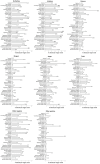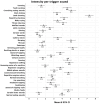Psychometric Evaluation and Misophonic Experience in a Portuguese-Speaking Sample
- PMID: 38392460
- PMCID: PMC10886306
- DOI: 10.3390/bs14020107
Psychometric Evaluation and Misophonic Experience in a Portuguese-Speaking Sample
Abstract
Misophonia, a disorder characterised by an extreme sensitivity to certain sounds, is increasingly being studied in cross-cultural settings. The S-Five scale is a multidimensional psychometric tool initially developed to measure the severity of misophonia in English-speaking populations. The scale has been validated in several languages, and the present study aimed to validate the European Portuguese S-Five scale in a Portuguese-speaking sample. The scale was translated into Portuguese using a forward-backwards translation method. The psychometric properties of the S-Five scale were evaluated in a sample of 491 Portuguese-speaking adults. Confirmatory factor analysis supported a five-factor structure consistent with previous versions of the S-Five scale. The five factors were as follows: (1) internalising appraisals, (2) externalising appraisals, (3) perceived threat and avoidance behaviour, (4) outbursts, and (5) impact on functioning. The satisfactory psychometric properties of the S-Five scale further indicated its cross-cultural stability. As a psychometrically robust tool, the S-Five can measure misophonia in Portuguese-speaking populations, allowing future studies to explore and compare misophonia in this population.
Keywords: Portuguese; misophonia; psychometrics; s-five; selective sound sensitivity syndrome; translation.
Conflict of interest statement
The authors declare no conflicts of interest.
Figures
References
-
- Jastreboff M.M., Jastreboff P.J. Components of decreased sound tolerance: Hyperacusis, misophonia, phonophobia. ITHS News Lett. 2001;2:5–7.
Grants and funding
LinkOut - more resources
Full Text Sources
Research Materials



